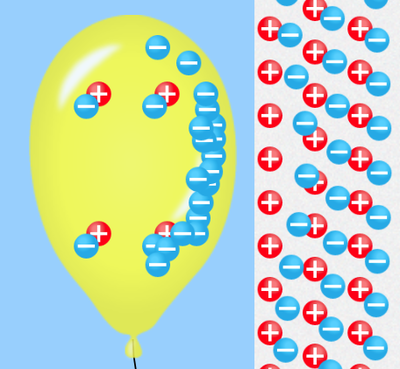Difference between revisions of "Electrostatic Induction"
| Line 4: | Line 4: | ||
===About Electrostatic Induction=== | ===About Electrostatic Induction=== | ||
| − | : [[Neutral | + | : [[Neutral Charge|Neutral]] [[object]]s are made of an equal number of [[Positive Charge|positively charged]] [[proton]]s and [[Negative Charge|negatively charged]] [[electron]]s. |
: The [[electron]]s around an [[atom]] can move, so when a [[Electrical Charge|charged]] [[object]] is placed near a [[Neutral (Physics)|neutral]] the [[electron]]s can move towards or away from that [[Electrical Charge|charged]] [[object]]. This is '''electrostatic induction'''. | : The [[electron]]s around an [[atom]] can move, so when a [[Electrical Charge|charged]] [[object]] is placed near a [[Neutral (Physics)|neutral]] the [[electron]]s can move towards or away from that [[Electrical Charge|charged]] [[object]]. This is '''electrostatic induction'''. | ||
Revision as of 21:52, 6 April 2019
Contents
Key Stage 3
Meaning
Electrostatic induction is when a charged object induces a charge in a neutral object.
About Electrostatic Induction
- Neutral objects are made of an equal number of positively charged protons and negatively charged electrons.
- The electrons around an atom can move, so when a charged object is placed near a neutral the electrons can move towards or away from that charged object. This is electrostatic induction.
To learn more about Electrostatic Induction click on each of the picture below for a PHET simulation and once the balloon is charged place it near the neutral wall to see the induced charge.
| In this diagram the balloon is charged with extra electrons which causes the electrons in the neutral wall to be repelled. |
Key Stage 4
Meaning
Electrostatic induction is when a charged object induces a charge in a neutral object.
About Electrostatic Induction
- Neutral objects are made of an equal number of positively charged protons and negatively charged electrons.
- The electrons around an atom can move, so when a charged object is placed near a neutral the electrons can move towards or away from that charged object. This is electrostatic induction.
To learn more about Electrostatic Induction click on each of the picture below for a PHET simulation and once the balloon is charged place it near the neutral wall to see the induced charge.
| In this diagram the balloon is charged with extra electrons which causes the electrons in the neutral wall to be repelled. |
